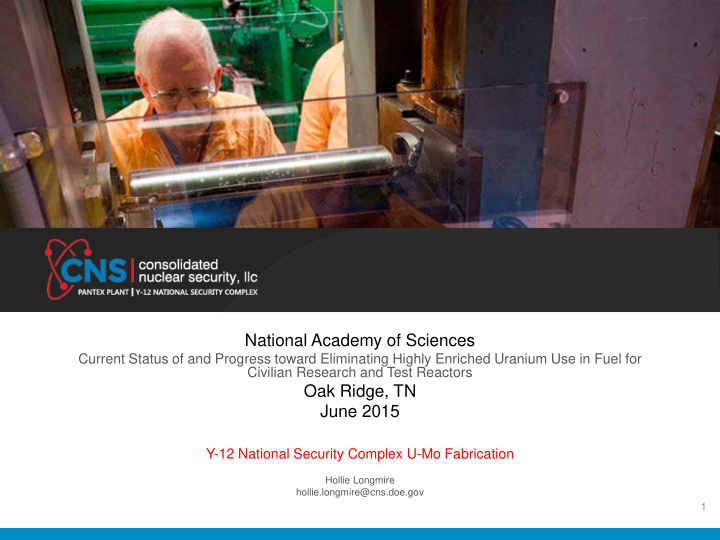



National Academy of Sciences Current Status of and Progress toward Eliminating Highly Enriched Uranium Use in Fuel for Civilian Research and Test Reactors Oak Ridge, TN June 2015 Y-12 National Security Complex U-Mo Fabrication Hollie Longmire hollie.longmire@cns.doe.gov 1
Disclaimer This work of authorship and those incorporated herein were prepared by Consolidated Nuclear Security, LLC (CNS) as accounts of work sponsored by an agency of the United States Government under contract DE-NA0001942. Neither the United States Government nor any agency thereof, nor CNS, nor any of their employees, makes any warranty, express or implied, or assumes any legal liability or responsibility for the accuracy, completeness, use made, or usefulness of any information, apparatus, product, or process disclosed, or represents that its use would not infringe privately owned rights. Reference herein to any specific commercial product, process, or service by trade name, trademark, manufacturer, or otherwise, does not necessarily constitute or imply its endorsement, recommendation, or favoring by the United States Government or any agency or contractor thereof, or by CNS. The views and opinions of authors expressed herein do not necessarily state or reflect those of the United States Government or any agency or contractor thereof, or by CNS. 2
Objectives • Initial phases of U-Mo Program at Y-12 • Progression of fabrication processes at Y-12 • Current fabrication process at Y-12 • Scrap recycle opportunities • Future process considerations 3
Initial Phases of U-Mo Program at Y-12 • Y-12 began preliminary alloy castings in 2006 • Preliminary casting molybdenum powder • Multiple melts required • Final product was heat treated and machined • Y-12 experimented with process variations to define a baseline process • Casting times • Casting temperatures • Casting geometries • Molybdenum forms: powder, rod and foil 4
Baseline Coupon Fabrication Concept 5
Alternate Casting Process 6
Proposed Optimized Casting Process 7
Coupon/Ingot Option Coupons Ingots • Center strip used for sampling • Sized determined by final foil • Larger ingots allow for greater requirements downstream processing • Requires specific cut diagrams flexibility • Increased material utilization 8
Optimized Casting Process: Campaign 1 Summary Weight Percentage of Uranium Weight Percentage of Molybdenum 93% 12% 92% 11% 91% 10% 90% wt% Mo wt% U 89% 9% 88% 8% 87% 7% 86% 85% 6% Top Middle Bottom Top Middle Bottom Sample Location Sample Location • Campaign 1 consisted of six castings • Each casting is three plates • Each plate is sampled three times: top, middle and bottom 9
Optimized Casting Process: Campaign 2 Summary Weight Percentage of Uranium Weight Percentage of Molybdenum 100.00% 12.0% 98.00% 10.0% Molybdenum Percent Uranium Percent 96.00% 8.0% 94.00% 6.0% 92.00% 4.0% 90.00% 2.0% 88.00% 0.0% Top Middle Bottom Top Middle Bottom Sample Location Sample Location • Campaign 2 consisted of eight castings • Each casting is three plates • Each plate is sampled three times: top, middle and bottom 10
Scrap Recycle Opportunities • Hot Top Recycle • Studies in progress • Chip Melting • Feasibility studies are complete • Greater that 90% yield/run • Continue studies to increase Technology Readiness Levels Recycled U-Mo Chips 11
Future Process Considerations • Surface Finish • Current process utilizes a machined surface finish • Studies underway to determine if as-cast surface is acceptable • Optimized Mold Geometry • As fuel fabrication processes are optimized, mold geometry can be adjust to reduce scrap and increase material utilization • Scrap Recycle Studies • Continue scrap recycle studies to optimize the re-use of recycled material 12
Recommend
More recommend